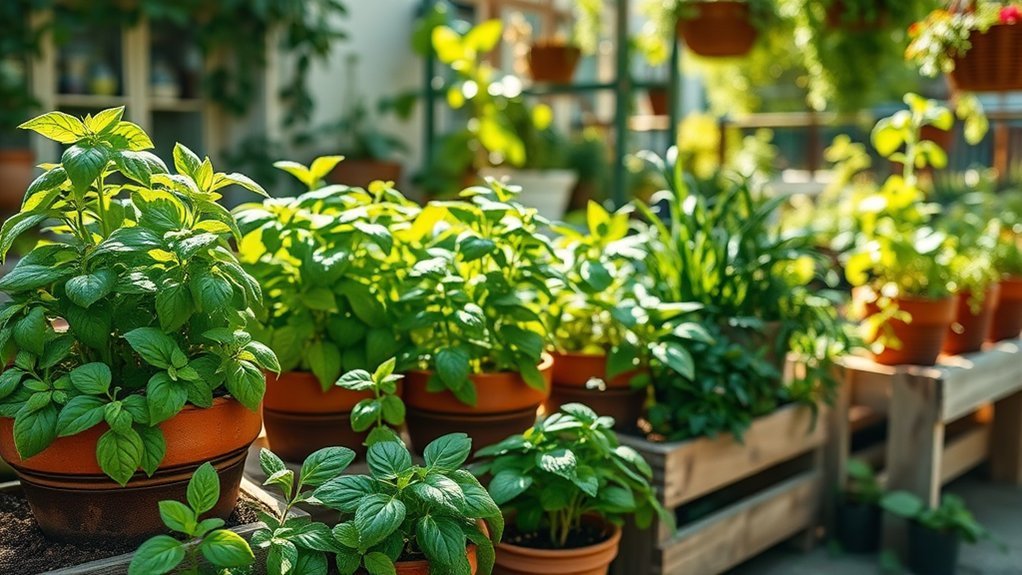Hey, want to spice up your home garden with herbs? Start by crafting neat herb borders for a tidy look, and use window boxes for easy kitchen access. Try vertical gardening with shoe organizers to save space, or build raised beds for better soil. Mix herbs with flowers to boost biodiversity, and add hanging baskets for flair. Ever thought of cascading plants like thyme? Stick around to uncover more cool tricks!
Key Takeaways
- Use herb borders to enhance garden structure by grouping herbs with similar light and water needs.
- Opt for window boxes in small spaces, ensuring full sun and well-draining soil for herbs.
- Build raised beds for better soil health and easier access when growing herbs.
- Mix herbs with pest-repellent flowers like marigolds to boost biodiversity and protect crops.
- Select herbs like rosemary and thyme for culinary use and companion planting benefits.
Crafting Herb Borders for Visual Appeal
While planning your home garden, why not start with crafting herb borders for visual appeal? Herb borders, like ones with Anouk lavender, can make your garden pop, and they even keep pests away from other plants.
Plus, grouping herbs with similar needs, like water or light, boosts their health. Ever thought about how neat that looks?
Ever considered grouping herbs by their needs for water or light? It not only helps them thrive but looks incredibly tidy too!
Try companion planting with rosemary, sage, or thyme in your herb borders, since they grow well together in the same soil.
Balance their heights for a tidy, structured look, okay?
And hey, add flowering herbs to attract beneficial pollinators, like bees, to help your garden thrive.
It? s like inviting tiny helpers to a party! Doesn? t that sound like a smart, simple plan?
Utilizing Window Boxes for Easy Access
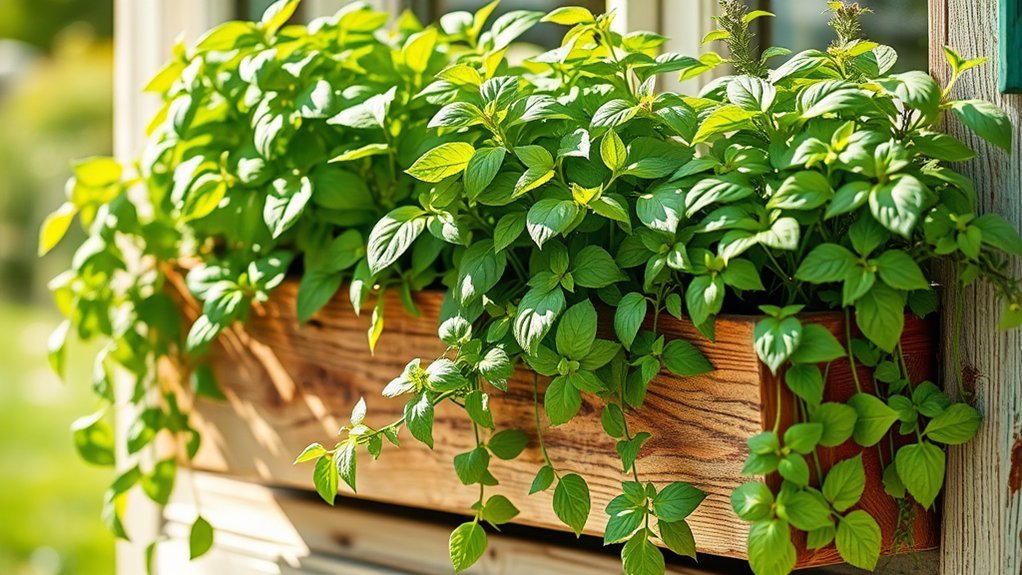
Hey, let? s switch gears and talk about using window boxes for growing herbs. If you? ve got limited space, a window box is perfect for fresh herbs right outside your window.
Just make sure it gets full sun, at least six hours daily, since most herbs love that light. Use well-draining soil, and check the drainage holes, so roots don? t rot.
Water often, as these boxes dry out fast? don? t let your plants go thirsty!
Ever tried companion planting? Pair herbs like basil and parsley in one window box; they grow better together and save space.
Got a favorite herb combo? Keep an eye on moisture, and you? ll have a handy mini-garden. It? s like having a spice rack on your windowsill!
Exploring Vertical Gardening With Shoe Organizers
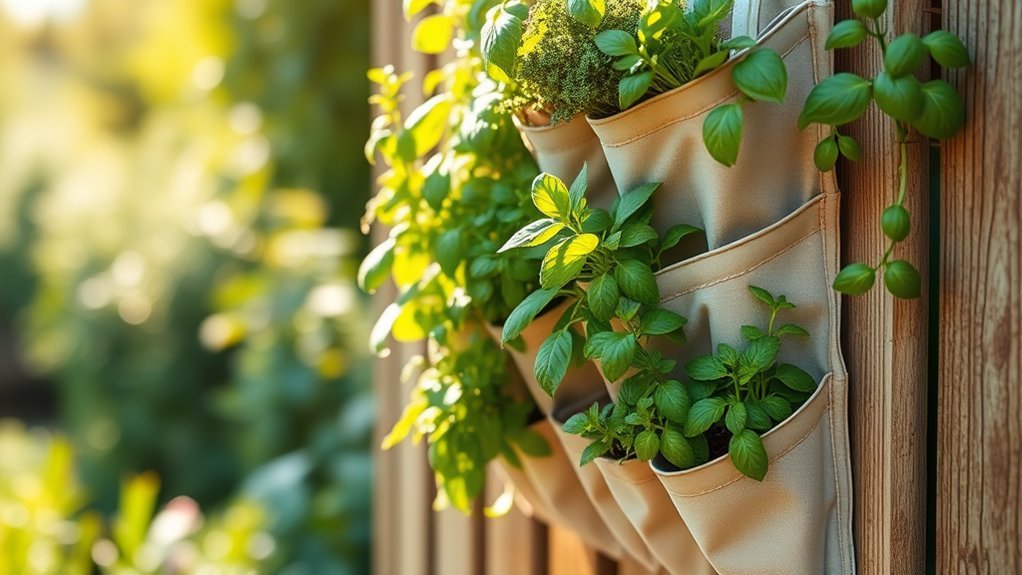
If you? re short on space, try vertical gardening with a shoe organizer for your herbs. It? s a smart way to maximize space, especially if your yard? s tiny. Hang it in a sunny spot, pop your herb pots in the pockets, and watch them grow. This setup saves ground space, keeps herbs handy for cooking, and adds cool aesthetic elements to your area.
Wondering how to arrange them? Check this table for a quick idea:
| Pocket Level | Herb Type | Sunlight Needs |
|---|---|---|
| Top (1-2) | Tall herbs (Basil) | High |
| Middle (3-4) | Bushy herbs (Thyme) | Medium |
| Bottom (5-6) | Small herbs (Mint) | Low |
| Extra (7-8) | Mixed herbs | Medium |
| Base (9-10) | Trailing herbs | Low |
Isn? t it like turning a shoe rack into a mini garden wall? Start today!
Building Raised Beds for Herb Cultivation
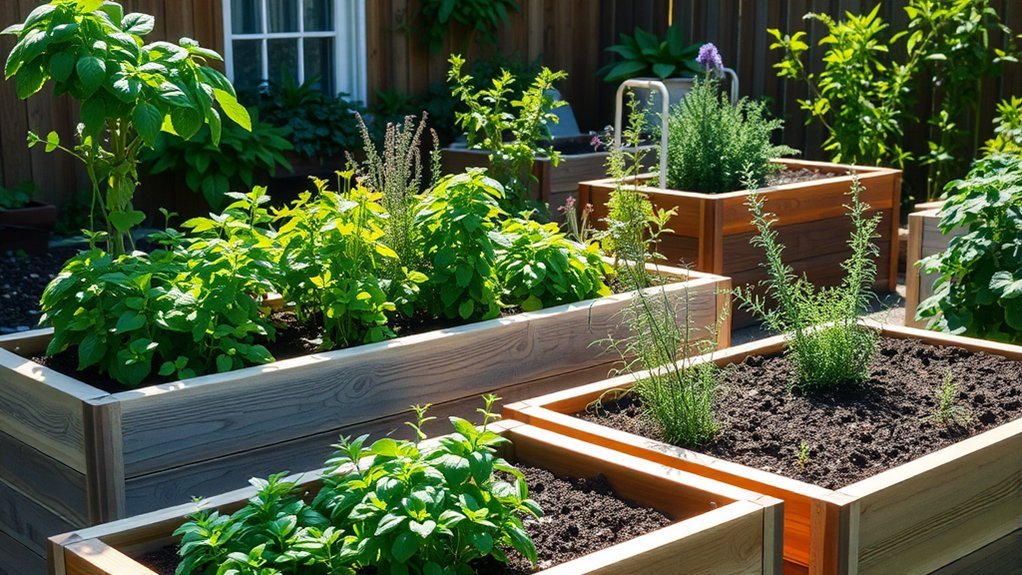
As you? re planning your herb garden, consider building raised beds for an awesome setup. A raised garden not only looks neat, but it also boosts soil health with well-draining soil, perfect for herbs like basil and thyme.
You? ll love how it saves your back, too, since you won? t bend over much while tending plants.
Ever thought about mixing things up? Try companion planting in your raised garden by pairing herbs with veggies for better growth and fewer pests.
Add barriers to keep critters out, and space the beds for good air and sun. It? s like giving your herb garden a cozy, protective home!
Raised beds also make it easier to create a family-friendly garden by ensuring accessibility for all ages.
Setting Up Windowsill Herb Displays
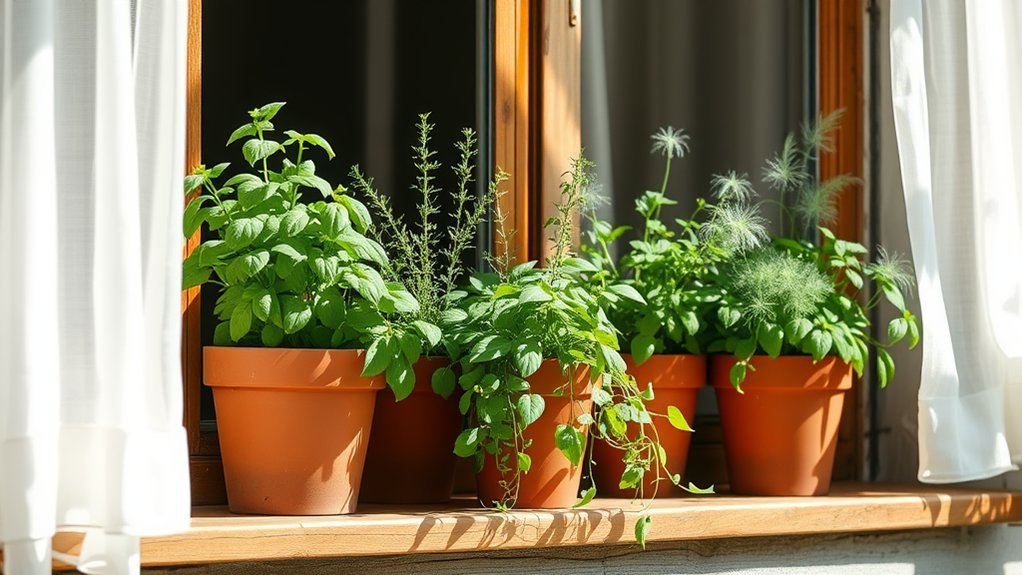
Ready to bring your herb game indoors? Setting up a windowsill herb display is super easy, and it? s a cool way to keep fresh herbs handy.
Pick a spot on your windowsill that gets at least 6 hours of sunlight daily, since herbs like basil need it to grow strong. Grab some containers with good drainage, maybe plastic or ceramic, to avoid soggy roots.
Wanna get creative? Use old teacups or mason jars for a fun look. Rotate your pots often, so each side gets sunlight, keeping your herbs nice and even.
Check humidity too? indoor air can be dry, so mist them regularly.
Hey, isn? t it neat to have a mini garden right by your window?
Embracing Xeriscaping With Drought-Tolerant Herbs
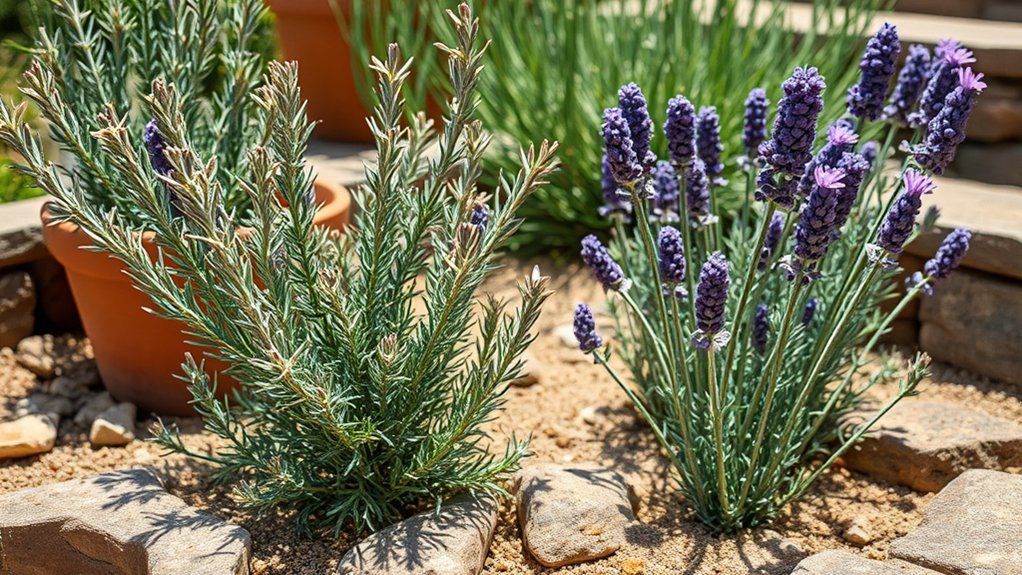
While you might love lush gardens, why not try xeriscaping with drought-tolerant herbs? It? s a smart way to save water, especially if you? re in a dry area.
Think of it like setting up a low-maintenance buddy system for your plants. Choose herbs like lavender, rosemary, and sage, which thrive in well-draining soil and don? t need much water once they? re settled.
Picture a low-maintenance plant posse! Opt for hardy herbs like lavender, rosemary, and sage, thriving with minimal water in well-draining soil.
To make it work, group plants with similar needs together, so you? re not overwatering some and neglecting others. This cuts down on upkeep, trust me.
Add mulch around your drought-tolerant herbs to keep moisture in and weeds out. Isn? t it cool to have a garden that? s easy and eco-friendly?
Give xeriscaping a shot, and watch it grow!
Inviting Pollinators With Flowering Varieties
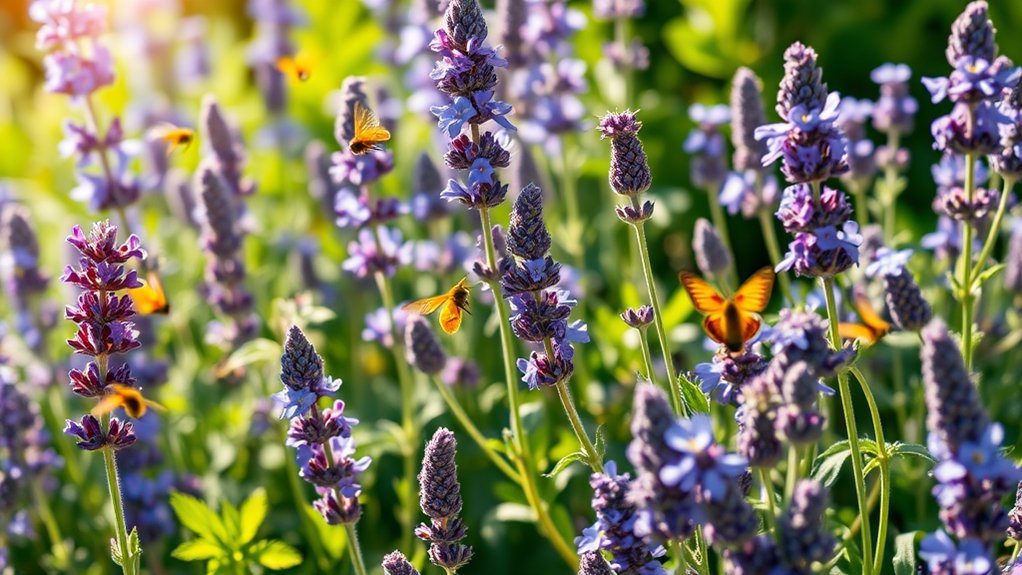
If you? re looking to boost your garden? s vibe, try inviting pollinators with flowering herbs. These plants, like thyme, oregano, and lavender, attract butterflies and bees, which help your garden grow.
You? ll see more life buzzing around, and it? s a simple way to enhance ecosystem health. Isn? t it cool to think your backyard can support nature?
Stick with nectar-rich flowering herbs, such as borage or bee balm, to keep pollinators happy. They? ll snack on the blooms while making your space prettier and more functional.
Plus, these herbs can even shoo away pests. Ever thought of your garden as a tiny wildlife haven? Just plant these varieties, watch the magic happen, and enjoy a livelier, healthier outdoor spot.
Mixing Herbs and Flowers for Biodiversity
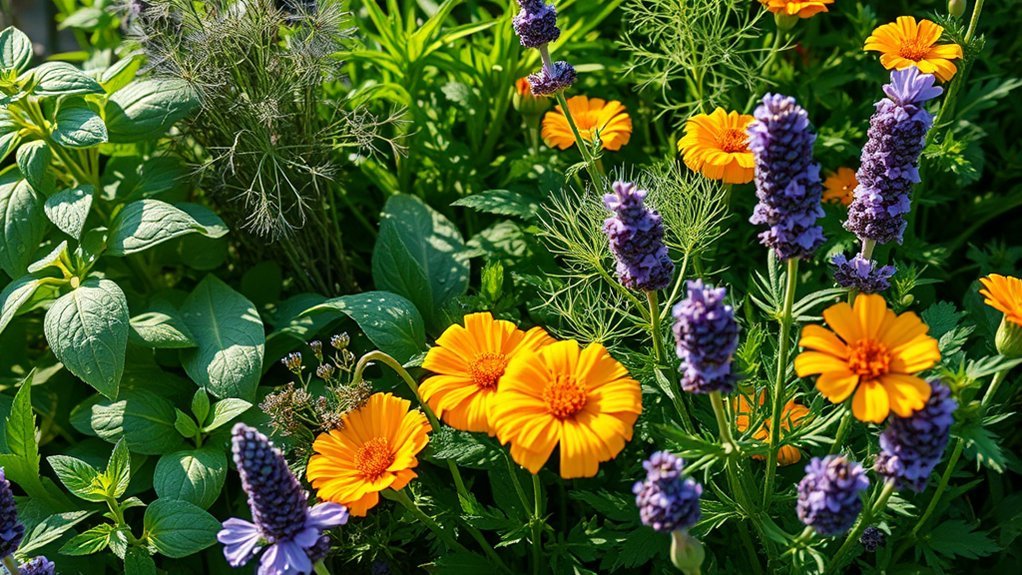
As you plan your garden, consider mixing herbs and flowers for awesome biodiversity. You? ll create a space that attracts bees and butterflies, which help plants grow.
Plus, pest-repellent flowers like marigolds keep bugs away from your herbs, so you don? t lose your crop. Isn? t that a handy trick?
Now, think about flowering herbs like thyme or rosemary. They? re not just pretty; they offer culinary benefits for your kitchen, adding flavor to meals.
These herbs also draw pollinators, boosting your garden? s health. Ever thought of tossing their blooms into a dish for a twist?
Mix in decorative flowers for a pop of color, and you? ve got a vibrant setup. So, why not try this combo for a thriving, useful garden?
Designing Hanging Baskets for Space Efficiency
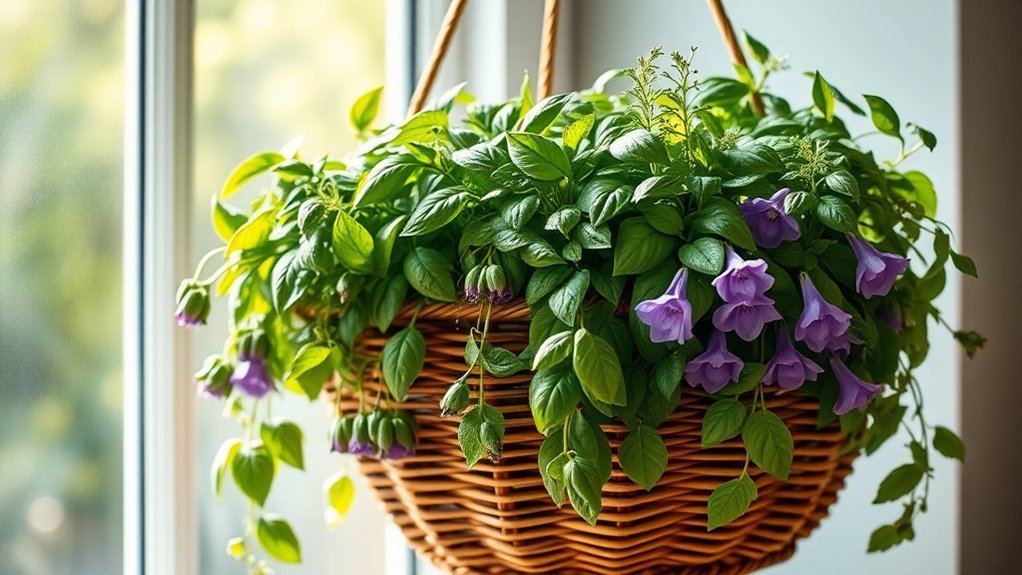
How can you make the most of a tiny garden space? Well, hanging baskets are your best bet for growing culinary herbs without taking up ground room. They let you use vertical space, so you can plant herbs like basil or oregano, even in a small spot.
Just imagine, it? s like stacking shelves for your plants!
Here? s how to start with hanging baskets:
- Pick lightweight baskets – Use wire or woven ones, so they? re easy to hang.
- Ensure adequate drainage – Get pots with holes or good soil mix to avoid soggy roots.
- Find sunny locations – Hang them where herbs get six hours of sun daily.
Enhancing Landscapes With Cascading Herb Plants
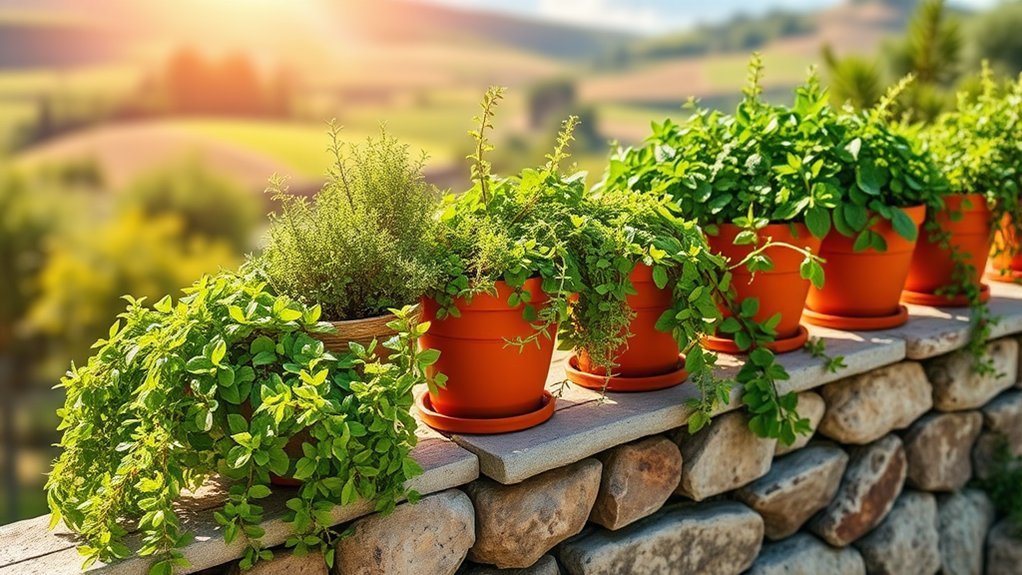
While you? re thinking about maximizing your garden space, let? s explore cascading herb plants. These beauties, like oregano and thyme, can transform your garden by adding texture to trellises or hanging baskets. They thrive in sunny locations, soften hard edges, and create a lush vibe. Plus, cascading herbs are low-maintenance plants, so you won? t stress over care. For more inspiration, discover how these plants can be part of budget-friendly landscaping solutions to elevate your outdoor space.
Curious which ones to try? Check this table for ideas:
| Herb | Best Spot | Bonus Perk |
|---|---|---|
| Lemon Balm | Hanging Baskets | Calming Scent |
| Creeping Thyme | Garden Edges | Attracts Bees |
| Oregano | Trellises | Great for Cooking |
| Rosemary | Wall Planters | Evergreen Look |
Harvest them for culinary use, and enjoy a functional, pretty landscape! What? ll you plant first?
Frequently Asked Questions
How Should I Arrange My Herb Garden?
Hey, wondering how to arrange your herb garden layout? Use companion planting strategies for better growth, try vertical herb gardening for space, and don’t forget seasonal herb rotation to keep things fresh and thriving!
Which Herbs Should Not Be Planted Together?
Imagine your garden as a battlefield of scents and flavors. You? ve gotta know which herbs clash! Use a herb compatibility chart to avoid toxic herb pairs, herb growth inhibitors, and refine companion planting strategies.
How Do You Start an Herb Garden for Beginners?
Hey, starting an herb garden is easy! Pick a sunny spot, grab container gardening pots, focus on soil preparation, and master watering techniques. You’ll soon nurture thriving herbs with minimal effort and care!
What Herbs Grow Well Together Chart?
As they say, knowledge is power! Immerse yourself in an herb compatibility chart and companion planting guide. Check seasonal herb pairings and soil preferences for herbs. You? ll craft a garden that? s thriving with synergy!
Conclusion
Hey, you? ve got the tools now to transform your home garden with herbs! Think borders, window boxes, and even shoe organizers? cool, right? But wait, what? s the next step? Will you hang baskets or build raised beds? Picture your space blooming, like a secret green hideout. So, which idea grabs you most? Let? s not stop here? dive in, experiment, and watch your herb haven grow. What? ll you try first?

